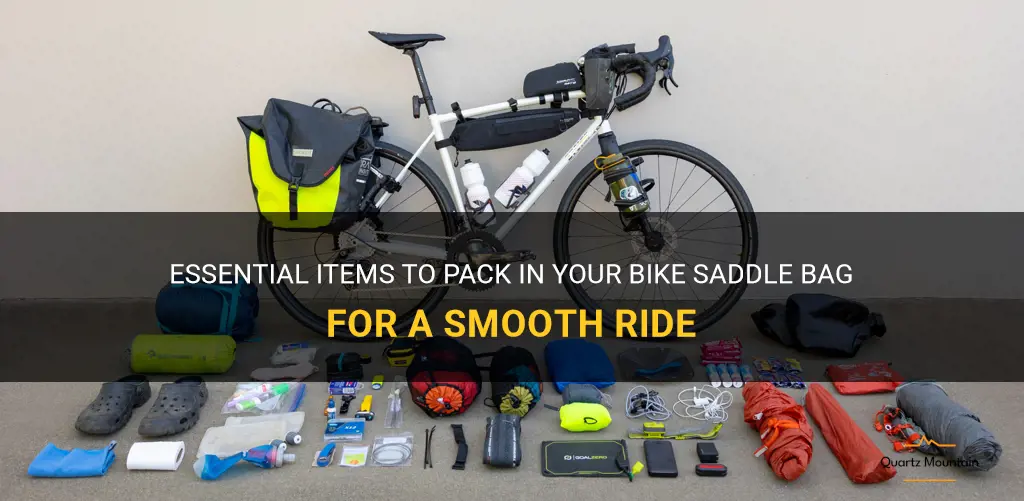
Are you an avid cyclist looking to embark on a long bike ride? Well, before you hit the open road, it's crucial to make sure you have all the essential items packed in your bike saddle bag to ensure a smooth and comfortable journey. From spare tubes and tire levers to a multi-tool and a mini pump, this handy guide will detail everything you need to bring along for a worry-free cycling adventure. So, grab your helmet and get ready to pedal like never before with all the necessary gear stashed away in your trusty saddle bag!
| Characteristics | Values |
|---|---|
| Size | Varies depending on the bag, typically ranging from 0.5L to 3L |
| Material | Most commonly made from durable nylon or polyester fabric |
| Attachment System | Usually equipped with Velcro straps or buckles to secure it to the seat post or saddle rails |
| Water Resistance | Many saddle bags are water-resistant or include a rain cover to protect contents from moisture |
| Compartments | May have one large compartment or multiple smaller pockets for organization |
| Capacity | Can hold essential items such as spare tube, tire levers, mini pump, patch kit, multitool, and energy bars/gels |
| Reflective Elements | Some bags have reflective strips or logos for increased visibility in low-light conditions |
| Weight | Typically lightweight, ranging from a few ounces to a pound |
| Ease of Access | Should have a zipper or quick-release buckle for easy opening and closing |
| Stability | A good saddle bag should stay securely attached to the bike without bouncing or swinging during rides |
What You'll Learn
- What are the essential items to include in a bike saddle bag?
- How do I determine the appropriate size of a bike saddle bag for my needs?
- Are there any specific tools or accessories that should always be packed in a bike saddle bag?
- Are there any safety items that should be included in a bike saddle bag?
- What are some common items that people often overlook when packing a bike saddle bag?

What are the essential items to include in a bike saddle bag?
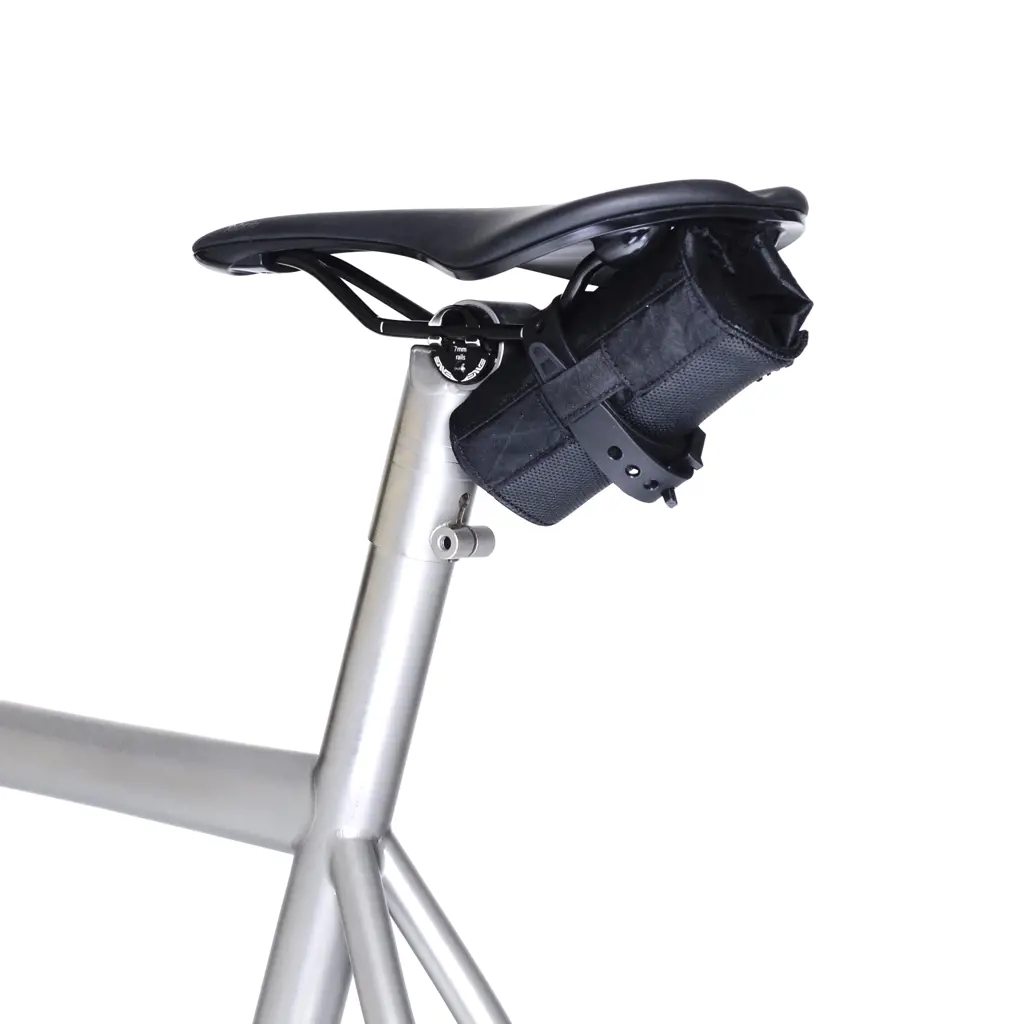
Bike saddle bags are a convenient accessory to have when heading out on a bike ride. They can hold essential items that may be needed during the ride, ensuring that you are prepared for any situation. It is important to pack your bike saddle bag efficiently and thoughtfully to ensure that you have everything you need without adding unnecessary weight or bulk. In this article, we will discuss the essential items to include in a bike saddle bag and provide some tips for packing it effectively.
- Spare tube and tire levers: One of the most important items to have in your bike saddle bag is a spare tube and tire levers. A flat tire is a common occurrence when riding a bike, and having a spare tube and tire levers can help you quickly fix the issue and get back on the road.
- Patch kit: In addition to a spare tube, a patch kit is also a great item to include in your saddle bag. Patch kits contain adhesive patches that can be used to repair small holes or punctures in your tube. This can be a lifesaver if you run out of spare tubes or have multiple flat tires on a ride.
- Mini pump or CO2 inflator: To inflate your spare tube or repaired tube, you will need a way to pump air into it. A mini pump or CO2 inflator is a compact and lightweight option that can easily fit in a bike saddle bag. These tools can quickly and efficiently inflate your tires, saving you time and effort.
- Multi-tool: A multi-tool is a versatile item that can come in handy in a variety of situations. It typically includes Allen wrenches, screwdrivers, and other tools that can be used to make on-the-go adjustments to your bike. Having a multi-tool in your saddle bag can help you handle unexpected mechanical issues during your ride.
- Cash and identification: It is always a good idea to have some cash and identification with you when riding your bike. In case of an emergency or if you need to make a pit stop, having some money and identification can be essential. Keep these items in a small waterproof bag within your saddle bag to protect them from moisture.
- Energy gels or snacks: Depending on the length and intensity of your ride, you may need some additional energy to keep you going. Pack a couple of energy gels or snacks in your saddle bag to give you a quick boost when you need it. Make sure to choose items that are compact and easy to consume while riding.
- Cell phone and charger: In today's digital age, most people always have their cell phone with them. Keep your cell phone and a small portable charger in your saddle bag in case of emergencies or if you need to make a phone call. Just make sure to keep them protected from moisture by placing them in a waterproof bag.
When packing your bike saddle bag, it is important to distribute the weight evenly to prevent it from shifting or affecting your ride. Place the heavier items towards the bottom of the bag and use lighter items to fill in any empty spaces. Avoid overpacking your saddle bag as it can become bulky and affect your comfort while riding.
In conclusion, a bike saddle bag is a useful accessory to have when cycling. By including essential items such as spare tubes, tire levers, patch kits, mini pumps or CO2 inflators, multi-tools, cash and identification, energy gels or snacks, and a cell phone, you can be prepared for any situation that may arise during your ride. Pack your saddle bag thoughtfully and efficiently to ensure that you have everything you need without adding unnecessary weight or bulk. Happy cycling!
Essential Clothing Items to Pack for Alaska in September
You may want to see also

How do I determine the appropriate size of a bike saddle bag for my needs?
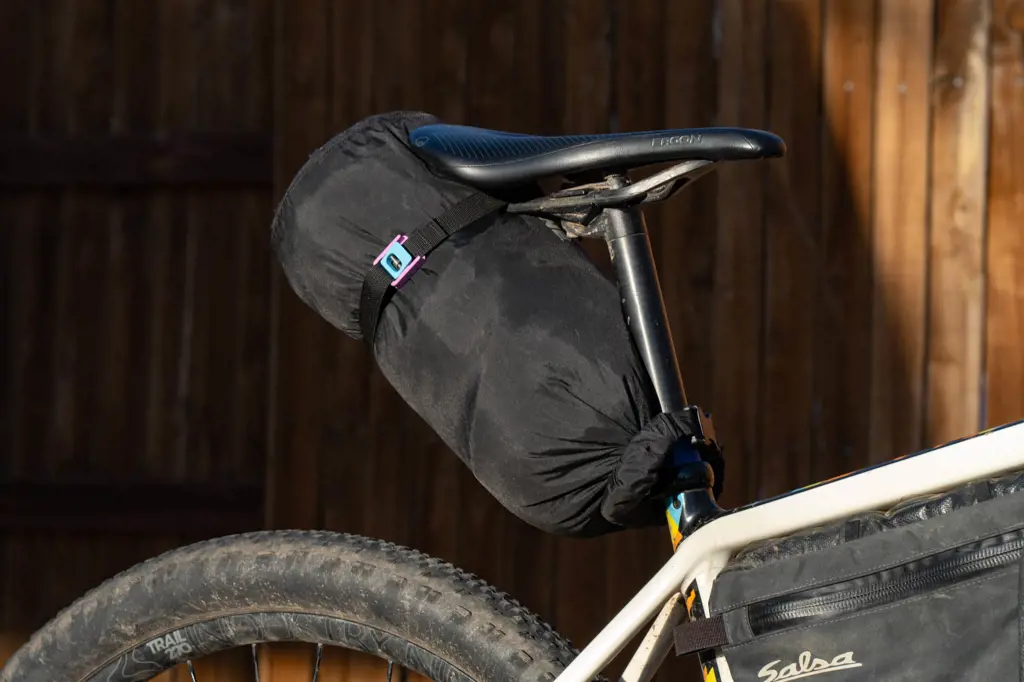
When it comes to biking, having a saddle bag is essential for carrying all your necessary items. But how do you determine the appropriate size of a bike saddle bag for your needs? In this article, we will explore some factors to consider when choosing the right size for your saddle bag.
- Consider Your Needs: The first step in determining the appropriate size of a bike saddle bag is to assess your needs. Think about what items you usually carry with you during your rides. Are you someone who likes to travel light, or do you prefer to have all the essentials with you? Taking stock of what you need to bring will help you choose a saddle bag that can accommodate your items.
- Size of the Bag: Bike saddle bags come in various sizes, ranging from small to large. Smaller bags typically have a capacity of around 0.5-1 liters and are suitable for carrying just the essentials like spare tubes, tire levers, and a multitool. Medium-sized bags have a capacity of 1-2 liters and can accommodate additional items such as a small pump or a lightweight jacket. Larger bags, with a capacity of 2-3 liters or more, can hold even more gear such as a mini pump, a spare jersey, or a small camera. Consider the size of the bag based on the number and size of the items you typically carry.
- Shape of the Bag: The shape of the saddle bag is also an important consideration. Some bags are narrow and elongated, while others are wider and shorter. The shape of the bag can affect how it fits under your saddle and how it affects your pedal stroke. Narrow, elongated bags may be more streamlined and less likely to interfere with your cycling, but they may have a smaller capacity. Wider bags may provide more storage space but may be bulkier.
- Attachment System: Another factor to consider is the attachment system of the saddle bag. Some bags use straps, while others use a clip or a quick-release mechanism. The attachment system should be secure and easy to use. Consider the compatibility of the attachment system with your saddle rails and seatpost, as well as how easy it is to attach and remove the bag.
- Personal Preference: Finally, personal preference plays a role in choosing the appropriate size of a bike saddle bag. Some cyclists prefer a minimalist approach and opt for a smaller bag to reduce weight and drag. Others may prefer to have more storage space and go for a larger bag. Consider your own preferences and how they align with your needs and the type of riding you do.
Examples:
Example 1:
John is a road cyclist who prefers to ride light and fast. He usually carries spare tubes, tire levers, and a multitool, so he opts for a small saddle bag with a capacity of around 0.5 liters. This allows him to have the essentials without adding unnecessary weight or drag.
Example 2:
Sarah is a mountain biker who likes to be prepared for any situation. She carries spare tubes, tire levers, a multitool, a small pump, a lightweight jacket, and a snack. She chooses a medium-sized saddle bag with a capacity of 1.5 liters to accommodate all her gear comfortably.
In conclusion, determining the appropriate size of a bike saddle bag is a combination of assessing your needs, considering the size and shape of the bag, evaluating the attachment system, and taking your personal preferences into account. By considering these factors, you can choose a saddle bag that suits your needs and enhances your biking experience.
The Essential Packing Guide for a November Trip to Jamaica
You may want to see also

Are there any specific tools or accessories that should always be packed in a bike saddle bag?
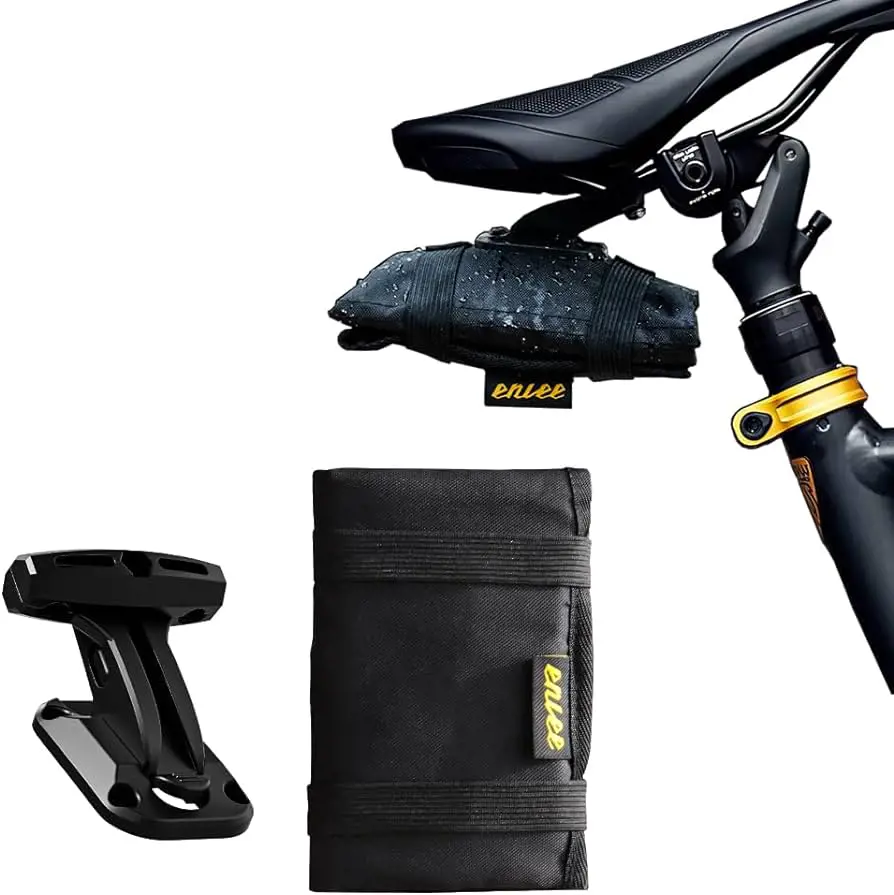
When cycling, it's important to be prepared for any unexpected situations that may arise. One way to ensure this is by always having a well-equipped bike saddle bag. A bike saddle bag is a small bag that attaches to the saddle of a bicycle and can hold essential tools and accessories. Here are some specific items that should always be packed in a bike saddle bag.
- Tire repair tools: A flat tire is a common occurrence while cycling, so it's essential to carry tire repair tools. This includes a spare inner tube or a patch kit, tire levers to remove the tire, and a mini pump to inflate the repaired or replaced tube.
- Multi-tool: A multi-tool is a versatile item that combines various tools into one compact device. It typically includes Allen wrenches in different sizes, a screwdriver, and a chain tool. This tool is useful for making adjustments and repairs on the go.
- CO2 cartridges or a small hand pump: In addition to a mini pump, it's a good idea to carry CO2 cartridges or a small hand pump. CO2 cartridges are quick and easy to use, providing instant inflation of a tire. However, they are single-use and can be more expensive in the long run. A small hand pump is a reliable option that allows for multiple uses and doesn't rely on cartridges.
- Spare tube or tubeless sealant: Besides carrying a spare tube, tubeless sealant is a good alternative for tubeless setups. It helps seal small punctures in tubeless tires, minimizing the need for a tube replacement. However, carrying a spare tube is always a good backup option and can be beneficial if the tubeless sealant fails to seal a larger puncture.
- Chain lubricant: Keeping the bike's chain well-lubricated is essential for smooth and efficient pedaling. A small container of chain lubricant can be packed in the saddle bag to ensure it's readily available when needed.
- Money and identification: It's always a good idea to carry some cash and identification while cycling. This can come in handy if you need to make an emergency purchase or if you require assistance.
- Energy gels or snacks: Cycling can be physically demanding, especially during long rides. Packing some energy gels or snacks can provide a quick boost of energy to help you stay fueled and focused.
- Reflective gear: Safety should always be a priority while cycling. Packing reflective gear, such as a reflective vest or ankle bands, can help increase your visibility, especially when riding in low-light conditions.
It's important to note that the size of the bike saddle bag may limit the number of items you can carry. Therefore, it's crucial to prioritize the most essential tools and accessories based on your cycling needs. Additionally, familiarize yourself with how to use each tool before heading out on a ride to ensure you can effectively perform any necessary repairs or adjustments. By packing these specific tools and accessories in your bike saddle bag, you can be better prepared for any unforeseen circumstances while enjoying your cycling adventures.
Essential Items to Pack for the New Orleans Jazz Fest
You may want to see also

Are there any safety items that should be included in a bike saddle bag?
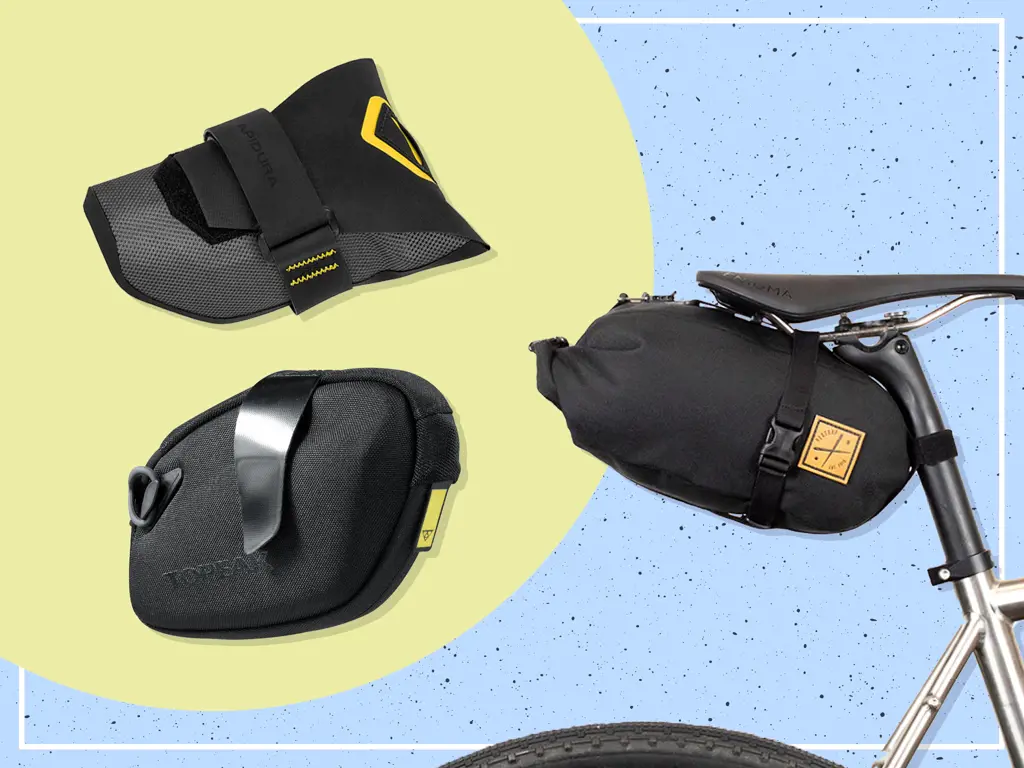
Having a bike saddle bag is a great way to carry essential items while riding. Not only does it provide convenience, but it can also contribute to rider safety. There are several safety items that should be included in a bike saddle bag to ensure a safe and enjoyable riding experience.
One of the most important safety items to carry in a bike saddle bag is a spare inner tube. Punctures can happen unexpectedly, and having a spare tube allows riders to quickly replace a damaged one and continue their journey. It is also essential to have the necessary tools, such as tire levers and a pump or CO2 inflator, to replace the tube efficiently. A small multi-tool should also be included in the saddle bag, as it can be used to make minor adjustments or repairs to the bike.
In addition to carrying tools and spare parts, it is crucial to include safety items that can be used in case of emergencies. A basic first aid kit should be included in the saddle bag to treat minor injuries sustained during a ride. This kit should contain items such as adhesive bandages, antiseptic wipes, and gauze pads. It is also a good idea to have a whistle or a small signaling device in the saddle bag, as it can be used to attract attention in case of an accident or an emergency situation.
Moreover, it is important to carry items that can enhance visibility and ensure that riders are seen by other road users. Reflective tape or a reflective vest are excellent safety items to include in the saddle bag. These can be easily attached to the bike or the rider's clothing to increase visibility, especially during low-light conditions or at night. A small flashlight can also come in handy to navigate dark areas or to signal other riders or vehicles.
Finally, having a small lock in the saddle bag can provide additional security for the bike. This can be useful when making quick stops or while grabbing a bite to eat during a ride. It is advisable to choose a lightweight lock that can easily fit inside the saddle bag without adding much weight.
In conclusion, there are several safety items that should be included in a bike saddle bag. These items include a spare inner tube, tools, a first aid kit, a signaling device, reflective items, and a lock. Carrying these safety items will help ensure a safe and prepared riding experience. It is important to periodically check the contents of the saddle bag and replenish any used or expired items. By being prepared and carrying these safety items, cyclists can have peace of mind while enjoying their ride.
Essential Items to Pack for a Memorable European Holiday
You may want to see also

What are some common items that people often overlook when packing a bike saddle bag?
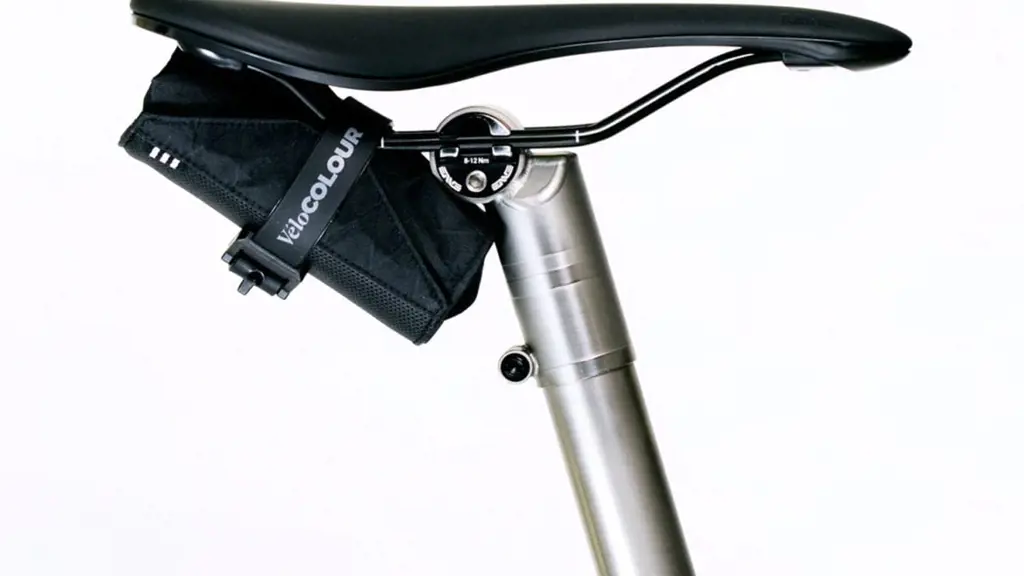
When packing a bike saddle bag, it's important to ensure that you have all the essential items with you for a safe and comfortable ride. While most riders remember to pack the basics such as a spare tube, tire levers, and a multitool, there are some common items that people often overlook. These items can come in handy in unexpected situations and should be included in your saddle bag setup.
One item that is often forgotten is a small first aid kit. While it may seem unnecessary for a short ride, accidents can happen, and having some basic supplies can make a big difference. A basic first aid kit should include adhesive bandages, antiseptic wipes, gauze pads, and medical tape. This can help you tend to minor cuts, scrapes, or blisters that may occur during your ride.
Another item that is frequently overlooked is a spare cleat bolt. Cleat bolts can come loose or get damaged over time, especially if you ride frequently. Having a spare bolt can save you from a potential walk or the hassle of trying to find a bike shop mid-ride. It's a small item, but it can make a big difference in keeping your shoes securely attached to the pedals.
Additionally, riders often forget to pack a small portable pump or CO2 cartridges. While many cyclists have a pump or cartridge at home, they may forget to transfer it to their saddlebag before heading out for a ride. Flat tires are one of the most common issues encountered on the road, and having a way to inflate your tire is crucial. A compact pump or CO2 cartridges can easily fit in your saddle bag and will allow you to quickly get back on the road.
It's also important to consider your ride duration and the weather conditions when packing your saddle bag. If you're going on a longer ride or in an area with unpredictable weather, it's a good idea to include a lightweight, packable rain jacket. You never know when the weather might take a turn, and having a jacket can keep you dry and warm if it starts to rain or gets chilly.
Extra batteries for your bike lights or a portable phone charger are other commonly overlooked items. If you're planning to ride in low-light conditions or for an extended period, having extra batteries or a way to charge your phone can help you stay visible and connected.
Finally, it's always a good idea to carry some cash or a credit card with you on your rides. While most shops and cafes accept card payments these days, there may be situations where you need to pay for something in cash or to call for a ride if you encounter any major bike issues. Having some money on hand can save you from being stranded or having to rely on the kindness of strangers.
In conclusion, when packing a bike saddle bag, it's important to consider not only the essentials but also some commonly overlooked items. A first aid kit, spare cleat bolt, portable pump or CO2 cartridges, lightweight rain jacket, extra batteries or a portable phone charger, and some cash or a credit card are all items that can come in handy during your rides. By being prepared and packing these additional items, you'll be ready for any situation that comes your way and can enjoy your rides with peace of mind.
The Ultimate Packing List for an 18-Day EBC Trek: Essentials for a Successful Himalayan Adventure
You may want to see also
Frequently asked questions
For a short ride, it is important to pack essentials such as a spare inner tube, tire levers, and a mini bike pump. These items will come in handy in case of a flat tire or other minor mechanical issues.
For a long ride, in addition to the essentials mentioned earlier, it is advisable to bring some extra items such as a multi-tool with various sized Allen keys, a chain tool, and a spare bike chain. These tools will allow you to make more extensive repairs if needed, ensuring you can continue your ride without any major setbacks.
While it is not necessary to pack food and water in your saddle bag, it is recommended to bring at least a small energy bar or gel and a bottle of water. These can be a lifesaver in case you get hungry or thirsty during your ride, especially on longer distances where water and food might not be readily available.
It is always a good idea to bring identification and a mobile phone with you when cycling, whether you keep them in a saddle bag, jersey pocket, or another secure location. This way, if anything were to happen during your ride, you would have a way to call for help or identify yourself if needed.







